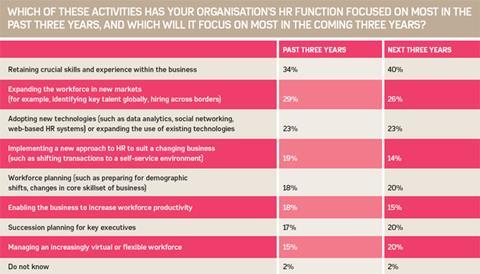IF YOU READ NOTHING ELSE, READ THIS…
- The economic climate, global expansion and talent management are key issues for chief executives in 2013.
- HR departments are instrumental in supporting employees to help deliver their organisation’s business strategy.
- Employee reward and benefits programmes play a key role in boosting strategic performance.
Businesses have been sorely tested during the economic downturn. Rising costs, high inflation and reductions in consumer spending have taken their toll, leaving organisations needing to boost efficiency and maximise returns on limited budgets.
The impact has been felt particularly by HR and reward professionals, who have often been called upon to support new business strategies or a change in direction.
Many organisations have been forced to adapt their business model to survive. Mark Wood, chairman of Jardine Lloyd Thompson Employee Benefits, says: “A typical chief executive of a FTSE 250 company in the UK is worried about global inflation and its impact on the supply chain. So whereas the consumer prices index (CPI) and retail prices index (RPI) are telling us that inflation is subdued, the reality is that the majority of businesses are experiencing raw material, power and wage input inflation to a much greater extent than the indices would suggest is the case.
“The level of consumption in the UK is dropping dramatically in almost every sector and, increasingly, I think there is a consensus building among economists that consumption will be subdued for some years to come. The consequence is that people will have to adjust to trading in a market that is not going to give them any real underlying growth in demand.”
In September, official figures from the Office for National Statistics (ONS) showed labour productivity fell in the second quarter of 2012, while labour costs, which include employers’ pension contributions and social security contributions, increased.
This predicament shows no signs of easing significantly next year. Alex Swarbrick, senior consultant at leadership institute Roffey Park, says: “Despite all the headlines saying the recession is over, there is no reason to think the economic climate will not be a predominant influence going into 2013.”
But these challenges are not always insurmountable. A study of 44,000 UK businesses that were on the brink of bankruptcy in 2006, published by information services firm Experian in October, found that 63% had survived. Of these, half had managed to turn their business fortunes around and improve their overall financial health.
So, as we move into 2013, what are the key issues keeping business leaders awake at night, and how can HR and reward professionals support them?
1. ECONOMIC CLIMATE
The economic climate is likely to be at the heart of almost every issue that will dominate chief executive officers’ (CEO) remits in 2013.
Although growth is forecast next year, it will be relatively small, particularly compared with the growth expected in economies such as China, says Swarbrick. “The forecast is looking better for 2013 than it did for 2012 in broad numerical terms, but I think the fact will remain that for most CEOs and CFOs [chief financial officers], the economic climate will be the paramount issue,” he says.
Engaged and motivated staff are essential for surviving an uncertain economic climate. However, the prolonged downturn means many people feel insecure and under pressure at work, particularly those surrounded by, or experiencing, pay freezes and job cuts.
“We have got an engagement and morale issue because we have a frightened and disillusioned workforce who would leave if they could, but they can’t because the job market is what it is,” says Swarbrick. “If we really want to keep these people and position ourselves for the 2013 economic climate, which might be better than 2012, how are we going to ensure these people aren’t simply here out of compliance, but out of commitment and they get some sense of purpose and recognition?
“It’s about HR and reward people paying attention to the broader sense of employee engagement, wellbeing and connection to purpose.”
An HR-driven engagement strategy can help employees feel connected to an organisation’s values. Reward and benefits, such as share schemes, can form a key part of this strategy.
2. MAXIMISING TOP-LINE REVENUE GROWTH
Maximising top-line revenue growth is a critical issue for businesses, particularly those operating in crowded marketplaces. James Berkeley, director of Berkeley Burke International, says: “The key for maximising top-line revenue growth in a market has been to make the customer think [the organisation is] the go-to brand. In business strategy terms, it needs to organise marketing teams, marketing people, and organisational strategy to create that really sharp siren call to stand out from the crowd. Behind that, [an organisation] needs to attract the right kind of people who understand what to do and help to keep a focus and discipline on making that happen.”
At a reward level, this may require reviewing how incentive schemes are structured to ensure they are encouraging desired employee behaviours and values. Berkeley says: “For example, if I see outstanding customer service, it makes me think this is a brand I’m willing to pay a premium for. So [employers] need to incentivise that behaviour.
“That might not just be monetary; it might be non-monetary in terms of the work people do, so they are constantly enjoying the work they are involved in and the career development opportunities that are offered, so they continually feel like being part of [the organisation], growing with the brand, and it is good for their career.”
Consequently, sales-based reward schemes may not be the best way to motivate employees. JLT’s Wood explains: “Aligning reward for performance is probably the most controversial issue HR departments will have to deal with in 2013 as we move to a culture in which we are more preoccupied with looking through remuneration structures to make sure there are no incentives causing an individual to behave to the detriment of the customer.”
Commission and incentive schemes may need to be modified to reflect issues such as customer satisfaction, fulfilment and retention, as well as the level of repeat custom, rather than rewarding staff based on the number of sales made.
3. INNOVATION
A key focus for CEOs is identifying new sources of revenue, be it through the development of new products or services, or moving into new markets. Innovation is crucial.
So, what can organisations do to encourage innovation and creativity throughout their workforce? Peter Cheese, chief executive of the Chartered Institute of Personnel and Development (CIPD), says: “It is really about ensuring that HR understands the business and the business strategy, particularly the value drivers within the business. What are the things that create value that HR can most impact and how does it most impact those? How do we also, in understanding those things and articulating with senior management, use real insights driven by better data analysis and understand the analytical insight into what is going on?”
Ensuring an organisation has the right people with the desired skills in place when required is a good place to start, as is a reward and benefits package tailored to specific groups of employees, rather than adopting a one-size-fits-all approach.
Cheese says workforces are becoming increasingly diverse. Successful businesses will be those that are best able to manage, and obtain value from, this diversity. However, they will be able to do so only if they provide the right benefits, talent management strategy and work-life balance options.
“The heart of it is being able to better understand the needs of different segments of the workforce and how they best work, how they best learn and how they are best encouraged to engage and perform,” explains Cheese.
4. GLOBAL EXPANSION
A report by Axa Group and MetLife’s Maxis Global Benefits Network in June 2012, based on an Economic Intelligence Unit survey, found that 40% of the multinationals surveyed plan to expand their operations in both developed and emerging markets.
The survey also found that nearly one-fifth of the organisations surveyed expect to have more than 85% of their workforce outside their home country in the next five years, which is nearly double the current figure.
JLT’s Wood says: “Successful companies over the next decade will be those that reposition their products and offerings to meet the consumer demands of growing markets, such as Brazil, Argentina and south-east Asia.”
HR professionals will be instrumental in identifying and recruiting the right staff to grow an organisation’s business in a new market. Among respondents to Maxis’ report, both HR and business executives felt benefits are critical when moving talent between locations. A large majority (90%) said benefits were a key factor in recruiting local talent, with benefits ranking second to salary in importance for globalisation strategies.
But when recruiting local talent, employers must tailor their compensation and benefits packages to take the local market into account, particularly for average pay and bonus levels.
Ensuring bonus and incentive schemes reflect the challenge of growing the business in a new market is also crucial, particularly if staff are taking on an expatriate assignment from an established market. So, employers should consider rewarding employee behaviour, rather than focusing solely on results.
Berkeley says: “Selling a new product to new customers may take more time and can result in greater levels of failure. So just because someone has failed but has applied the right processes, should they be disadvantaged to the person who works in a mature market where it is pretty easy to sell a repeat product?”
When setting a remuneration or incentive strategy in overseas markets, employers should consider their longer-term goals. Taking a bigger financial hit now to refl ect the different levels of challenge employees face could pay off in the future if it results in them achieving their desired level of growth in locations such as China or Brazil.
5. TALENT MANAGEMENT
The Maxis Global Benefits Network report found that two-thirds of respondents expected talent shortages to affect their bottom line in the next five years.
Robert Bolton, partner, HR transformation centre of excellence at KPMG, says: “Up until 2008, organisations recruited hand over fist, so what talent really meant was recruitment and how to get their share of the best people. Now the debate has moved on and the challenges in the talent world are how to retain people, particularly where there is evidence that the number of people that are disengaged is on the increase.”
The CIPD’s Cheese says that for HR directors to ensure their focus is aligned with their executive leadership, they must consider the business as it is today, where it will be positioned in the future, the critical skills and capabilities required to achieve this, and the potential skills gaps along the way.
A reward package that offers employees value, support, recognition for their work, ample opportunities for career development and a good working environment is crucial for retaining staff with key skillsets.
Line managers are instrumental in the successful delivery of this package. Cheese says: “Line managers are crucial, so we have to ensure we focus on their people management capabilities much more, including better understanding and measuring their own behaviour. We must pay more attention to recognising and rewarding really good people managers who can build engaged teams.”
As well as a simple thank-you, rewards offered through recognition schemes can range from cash bonuses and motivation vouchers to share awards.
Maintaining engagement and morale should be part of managers’ efforts. As Swarbrick says: “If we let morale, engagement and wellbeing slip, there is a negative relationship to strategic performance. So we do that at our peril. The good news is that all those things that positively correlate to strategic performance are in the people agenda and are waiting for HR to make a more significant impact.”
CASE STUDY: NUANCE COMMUNICATIONS

Global framework supports growth
Nuance Communications has created a global framework within its HR and reward functions to support its international expansion strategy. The process involved collaboration between its compensation and benefits, and merger and acquisition (M&A) teams.
As well as growing organically, the company makes a number of acquisitions each year. Spencer Roach, compensation and benefits manager international at Nuance, says: “It is very acquisitive, very fast-growing. At any given time, I seem to be dealing with two or three acquisitions.”
The framework to support this activity includes a number of templates that can be used during an M&A, for example to help it to identify retention issues at an early stage and a due-diligence checklist. In terms of compensation, Nuance also has also a job code structure and a global survey provider. Together, these enable it to slot an employee into a structure, which can be immediately tied to local market data and practices, says Roach.
“By having that globalised model, we can quickly get localised information on the ground. It gives us something to aim for. You are giving consistency, but you are also quickly able to offer people something extra. People can start to see the value of being in a larger, more global organisation.”
Nuance’s benefits templates include a tool that has details of all its benefits around the world, as well as templates that enable it to compare benefits in local markets. “That analysis approach enables us to figure out the best options,” says Roach.
Its relationship with global broker Aon Hewitt often helps it obtain better terms.
VIEWPOINT

Angela Wright, senior lecturer in HR, Westminster Business School
During the 1990s, the ‘new pay’ writers said reward practices should be used to achieve strategic business objectives, and other strategic reward priorities should be subordinate. How this should be achieved has been hotly debated since then.
For most service-based organisations, pay and benefits account for 70% to 80% of corporate costs. Yet there is relatively little evaluation of whether their reward systems are delivering value for money.
Much research on reward system evaluation shows how hard it can be to disentangle the effect of reward from the wider employment experience. However, as costs in many organisations continue to be constrained, the focus is on achieving bottom-line value from pay and benefits.
The emphasis for many organisations may be, on the one hand, using pay to ameliorate the harmful effect of loss of talent. The CIPD [Chartered Institute of Personnel and Development] Employee outlook survey, published in June 2011, shows the prime reason for staff wanting to change jobs relates to pay and benefits. On the other hand, in many organisations there are no real increases in pay for most staff. For many, the ‘push’ effect on pay from cost-of-living rises is constrained by employee fears of unemployment.
Even so, employers can still seek to use reward to deliver positive organisational outcomes. The government’s Workplace employment relations survey, published in 2004, showed employee satisfaction with the amount of pay received is associated with employee commitment, which can have a direct effect on business outcomes.
So, it is important to focus on pay satisfaction and understand that it may be associated more with what is termed procedural justice.
This concept implies that people can even accept that pay cuts are fair if they buy into the reasons for them. So, the emphasis for managers should probably be much more on reward communication.





























